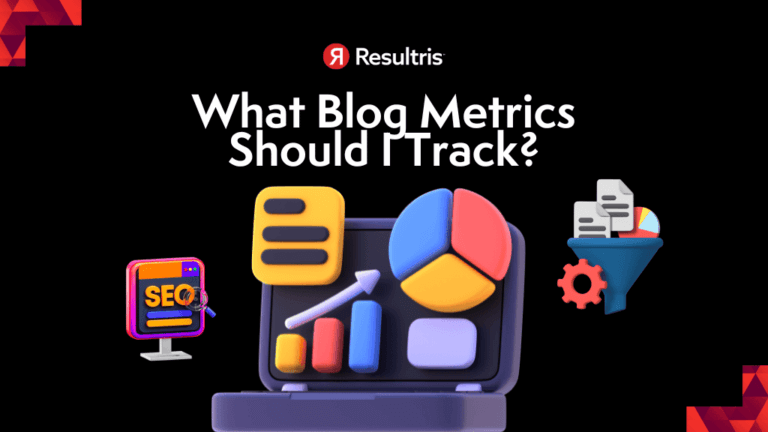

Blog metrics are crucial in evaluating the success of your content and helping you improve your blogging efforts. Key blog metrics to track include:
Monitoring these metrics provides valuable insights and enables you to optimize your content strategy for better results.
Tracking blog metrics allows you to measure your content’s success, pinpoint improvement areas, and optimize your strategy for better results. Identifying relevant metrics ensures data-driven decision-making, resulting in increased audience engagement and conversions.
Here are the essential blog metrics you should track to ensure your content strategy is effective and continuously improving:
Unique visitors represent the number of individuals visiting your blog. This metric helps you understand your blog’s reach and the potential size of your receptive audience.
Pageviews measure the total number of times your blog pages are viewed. This indicator helps you check the overall interest in your content and identify popular pages that can inform future content strategy.
Average time on page estimates the time visitors spend on a page. This metric gives insights into the relevance and engagement of your content, with a longer average time indicating valuable content.
Bounce rate refers to the percentage of visitors who leave your blog after viewing only one page. A high bounce rate signals your content isn’t capturing the audience’s attention or meeting their needs.
Social shares count the times your content is shared across social media platforms. This metric gauges your content’s shareability, potential vitality, impact reach, and brand awareness.
The number of comments on your blog posts reflects reader engagement and interaction. High-quality, thought-provoking content typically invites more comments and fosters a sense of online community.
The conversion rate represents the percentage of visitors who take a desired action, such as signing up for a newsletter or purchasing. This metric helps you measure the success of your content in driving specific goals or objectives.
Organic search traffic is the number of visitors arriving at your blog from search engine results. This metric underlines the effectiveness of your SEO efforts and content discoverability, leading to more long-term and sustainable growth.
Need Engaging Blog Posts for Your Business? ✍️
Quality blog content can elevate your brand and connect you with your target audience like never before. Explore our Blog Writing Services and ensure every post leaves a lasting impression.
In addition to the essential blog metrics listed above, consider tracking the following metrics to develop a broader understanding of your blog’s performance:
Analyzing the ratio of returning visitors to new ones provides insights into your audience’s overall engagement and loyalty. Successful blogs aim to balance attracting fresh visitors while retaining a loyal readership.
Traffic sources refer to the various channels that direct visitors to your blog, such as search engines, social media, email, or referrals. This metric helps you evaluate the effectiveness of your marketing efforts and identify areas that need improvement.
Keep track of your most popular content to understand which topics or formats resonate with your audience. Use this data to optimize and repurpose successful content for various platforms.
Scroll depth measures how far down the page your visitors read, assisting in understanding their engagement with lengthy content. This metric lets you modify content length and structure to maximize audience attention.
To optimize your blog’s performance, follow these steps:
Establish specific, measurable, achievable, relevant, and time-bound (SMART) goals for your content strategy, such as increasing engagement or improving organic search rankings. Choose metrics that align with these objectives.
You can keep a pulse on your blog metrics through regular monitoring. Many platforms offer built-in analytics or integrate with external tools, such as Google Analytics, for reliable tracking.
Experiment with different content formats, headlines, post timing, and marketing tactics to uncover what resonates with your audience. Use A/B testing to compare variations to optimize your strategy continually.
Use the data and insights from tracking blog metrics to inform content creation and optimization. Update your strategy in response to the insights gained from monitoring your metrics.
Looking for Expert Content Creation? ?
Crafting compelling content is an art and science combined. Don’t let your brand message get lost in the noise. Discover our Content Writing Services and let us help you resonate with your audience.
After reading about the importance of tracking blog metrics, you may have questions about specific details or best practices. Here are some frequently asked questions and concise answers to help address your concerns:
It’s best to monitor your blog metrics regularly, preferably weekly or monthly, depending on your publishing frequency. However, avoid over-analyzing data to prevent short-term fluctuations from skewing your content strategy.
Popular tools for tracking blog metrics include Google Analytics, WordPress plugins like Jetpack, and all-in-one marketing platforms like HubSpot or SEMrush. Choose the tool that aligns with your objectives and accurately tracks essential metrics.
To improve your bounce rate, create more engaging content with clear call-to-actions and internal links to related articles. Additionally, ensure your website’s seamless user experience with fast load times and responsive design.
To increase social shares, create share-worthy content, add eye-catching images, and use engaging headlines. Make sharing easy by incorporating share buttons on your blog posts and promoting your content on your social media accounts.
Yes, blog metrics can guide you in generating more relevant content. By reviewing your top-performing posts, average time on page, and audience engagement metrics, you can better understand your audience’s preferences and create content that resonates with them.




